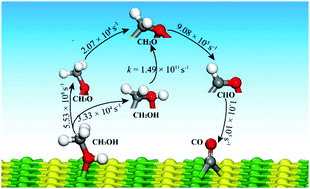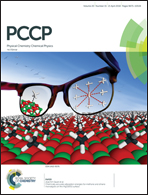Exploring the methanol decomposition mechanism on the Pt3Ni(100) surface: a periodic density functional theory study†
Abstract
The detailed mechanism of the methanol decomposition reaction (MDR) on the Pt3Ni(100) surface is studied based on self-consistent periodic density functional theory calculations. The geometries and energies of methanol and its intermediates involved in MDR are analyzed, and the reaction network is constructed to illustrate the MDR mechanisms. The possible pathways through initial scission of the O–H, C–H, and C–O bonds in methanol are discussed based on the steric effect and electronic structure of the related transition states and the Brønsted–Evans–Polanyi (BEP) relationships. The initial scission of the O–H bond is favorable and bears the lowest energy barrier among the three decomposition modes (initial scission of O–H, C–H, and C–O bonds). Potential energy surface (PES) analysis confirmed that although the initial scission of the O–H bond is more favorable than scission of the C–H bond, the initial scission of the C–H bond can actually occur because of the very low energy barrier for further dehydrogenation of CH2OH via scission of its O–H bond. Thus, the pathway for MDR on the Pt3Ni(100) surface may possibly proceed via two competitive pathways: CH3OH → CH3O → CH2O → CHO → CO and CH3OH → CH2OH → CH2O → CHO → CO. Comparisons between the current results and the MDR on other systems are made and show that Pt3Ni(100) can be a good catalyst for MDR.



 Please wait while we load your content...
Please wait while we load your content...